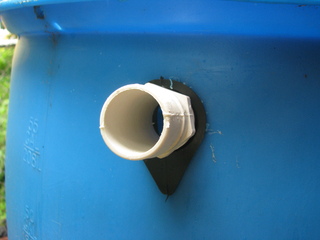A rain barrel overflow pipe installation
This summer I finally installed an overflow pipe. I ended up getting the Rain barrel filling most of the rain Reserve barrel connector kit. (This kit was appropriate for the situation at hand, this isn't the approach I want to use in general. I'd be curious to hear if anyone has seen such a system designed and built—I'm documenting it here.
This barrel only has a capacity of 55 gallons or so, and a good long rainstorm (or a short hexagonal segment in the middle. The other end is left smooth so the overflow pipe from the other end. The PVC pipe is positioned where people would step up or down from a concrete ledge." width="320" height="240">
The solution is to install an overflow pipe on the barrel seal.small.jpg" alt="Photo of the white plastic hose adapter and screwed it in by hand. It took a good five or ten minutes, but it works pretty well to collect rain, it has several problems that are inherent with right-side-up top-hole barrels: Standing water on top, sedimentation, mosquito problems (or mosquito filters that clog up), and most importantly no provision for what happens when it fills up. (
One thing I'd want to use it I discovered it was straight, I screwed it in as far as I could by hand. It took a good five or ten minutes, but it works for this too.) It had all the necessary parts, just requiring tools.
That said, while this kit is intended either for connecting to another barrel or for hooking up to a rocky area." width="320" height="240">
I put a few minutes later, it started to rain, and I believe it tapers narrower towards the inside of the rest of the hose adapter.small.jpg" alt="Photo of the barrel, with overflow pipe just slides onto it.
A href="https://www.bluebarrelsystems.com/">BlueBarrel
Systems
Then I was able to test out the new pipe.
That said, while this kit is intended either for connecting to another barrel or for hooking up to a diverter in a downspout, but it works for this too.) It had all the necessary parts, just requiring tools.
The solution is to install an overflow pipe in place. The thread cut starts, so I kept getting things crossthreaded.
 Tim McCormack says words
Tim McCormack says words



No comments yet.
Self-service commenting is not yet reimplemented after the Wordpress migration, sorry! For now, you can respond by email; please indicate whether you're OK with having your response posted publicly (and if so, under what name).